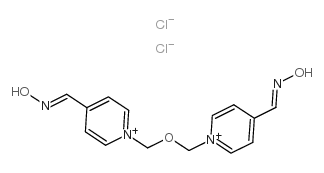Obidoxime dichloride

Obidoxime dichloride structure
|
Common Name | Obidoxime dichloride | ||
|---|---|---|---|---|
| CAS Number | 114-90-9 | Molecular Weight | 359.20800 | |
| Density | 1.33g/cm3 | Boiling Point | 1132.2ºC at 760 mmHg | |
| Molecular Formula | C14H16Cl2N4O3 | Melting Point | 216-219ºC dec. | |
| MSDS | Chinese USA | Flash Point | 638.5ºC | |
|
Development and validation of a FIA/UV-vis method for pK(a) determination of oxime based acetylcholinesterase reactivators.
J. Pharm. Biomed. Anal. 117 , 240-6, (2015) Acetylcholinesterase reactivators (oximes) are compounds used for antidotal treatment in case of organophosphorus poisoning. The dissociation constants (pK(a1)) of ten standard or promising acetylcholinesterase reactivators were determined by ultraviolet abso... |
|
|
sec-Butyl-propylacetamide (SPD) and two of its stereoisomers rapidly terminate paraoxon-induced status epilepticus in rats.
Epilepsia 55(12) , 1953-8, (2014) Organophosphates (OPs) are commonly used insecticides for agriculture and domestic purposes, but may also serve as nerve agents. Exposure to OPs result in overstimulation of the cholinergic system and lead to status epilepticus (SE), a life-threatening condit... |
|
|
Effect of different oximes on rat and human cholinesterases inhibited by methamidophos: a comparative in vitro and in silico study.
Basic Clin Pharmacol Toxicol. 111(6) , 362-70, (2012) Methamidophos is one of the most toxic organophosphorus (OP) compounds. It acts via phosphorylation of a serine residue in the active site of acetylcholinesterase (AChE) and butyrylcholinesterase (BChE), leading to enzyme inactivation. Different oximes have b... |
|
|
Investigation of kinetic interactions between approved oximes and human acetylcholinesterase inhibited by pesticide carbamates.
Chem. Biol. Interact. 206(3) , 569-72, (2013) Carbamates are widely used for pest control and act primarily by inhibition of insect and mammalian acetylcholinesterase (AChE). Accidental or intentional uptake of carbamates may result in typical signs and symptoms of cholinergic overstimulation which canno... |
|
|
Prevention of organophosphate-induced chronic epilepsy by early benzodiazepine treatment.
Toxicology 323 , 19-25, (2014) Poisoning with organophosphates (OPs) may induce status epilepticus (SE), leading to severe brain damage. Our objectives were to investigate whether OP-induced SE leads to the emergence of spontaneous recurrent seizures (SRSs), the hallmark of chronic epileps... |
|
|
[Studying kinetics of oxime-induced reactivation of malathion-inhibited cholinesterase].
Eksp. Klin. Farmakol. 76(1) , 21-4, (2013) The kinetics of oxime-induced reactivation of malathion-inhibited cholinesterase has been experimentally studied in vitro. It is shown that oximes do not restore the activity of inhibited butyrylcholinesterase. Acetylcholinesterase reactivation peak (5-mins l... |
|
|
Syntheses and in vitro evaluations of uncharged reactivators for human acetylcholinesterase inhibited by organophosphorus nerve agents.
Chem. Biol. Interact. 203(1) , 81-4, (2013) Organophosphorus nerve agents (OPNAs) are highly toxic compounds that represent a threat to both military and civilian populations. They cause an irreversible inhibition of acetylcholinesterase (AChE), by the formation of a covalent P-O bond with the catalyti... |
|
|
A comparison of the potency of a novel bispyridinium oxime K203 and currently available oximes (obidoxime, HI-6) to counteract the acute neurotoxicity of sarin in rats.
Basic Clin Pharmacol Toxicol. 111(5) , 333-8, (2012) The neuroprotective effects of a newly developed oxime K203 and currently available oximes (obidoxime, HI-6) in combination with atropine in rats poisoned with sarin were studied. The sarin-induced neurotoxicity was monitored using a functional observatory ba... |
|
|
A common mechanism for resistance to oxime reactivation of acetylcholinesterase inhibited by organophosphorus compounds.
Chem. Biol. Interact. 203(1) , 72-6, (2013) Administration of oxime therapy is currently the standard approach used to reverse the acute toxicity of organophosphorus (OP) compounds, which is usually attributed to OP inhibition of acetylcholinesterase (AChE). Rate constants for reactivation of OP-inhibi... |
|
|
[Antidotal effect of combinations obidoxime/HI-6 and memantine in mice poisoned with soman, dichlorvos or heptenophos].
Vojnosanit. Pregl. 68(12) , 1033-40, (2011) In acute organophosphate poisoning the issue of special concern is the appearance of muscle fasciculations and convulsions that cannot be adequately antagonised by the use of atropine and oxime therapy. The aim of this study was to examine atidotal effect of ... |